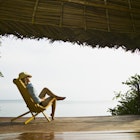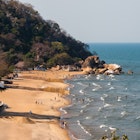

Here are the best ways to travel around in Malawi ТЉ wilpunt / Getty Images
Getting around Malawi is easy compared with many other African countries.
There is a good coach network that connects all the main settlements, roads are in reasonable condition, and cars are generally roadworthy. The motola minibus system is affordable, but traveling this way can cause frustration because the minibuses wonтt leave until they are (unsafely) packed to the max with passengers. Visitors to Lake Malawi should consider traveling by ferry т the antique MV Ilala т rather than driving. Though the timetable is loose at best, itтs a romantic and scenic way to explore the lake.
In the capital of Lilongwe, you will probably depend on taxis because the cityтs sprawling layout isnтt conducive to walking. Blantyre is more walkable but choked with traffic, while the leafy avenues of Zomba are a pleasure to explore on foot.
Anyone considering a visit to a national park will either have to rent a 4WD vehicle or hire a driver. The roads can be rough in remote places such as Nyika, and the rains make dirt tracks difficult to navigate.
Here are our top tips to help you safely find your way around in Malawi.

Take the ferry on Lake Malawi for a memorable experience
The MV Ilala has been plowing up and down Lake Malawi for over 70 years and offers a unique perspective on this gorgeous body of water. The leisurely schedule takes the ferry up and down the lake once a week in each direction, from Monkey Bay in the south to Chilumba in the north. Itтs not a luxurious experience, but it is a deeply characterful one, especially if you can splash out on a cabin. Drinks, snacks and meals are available onboard.
Malawi has a good coach network between regions
Malawi is crisscrossed by a dependable and competitive coach network. It can be a sociable way to travel: you can chat to fellow passengers and get a panoramic view of the beautiful passing countryside. The main contenders are Axa and SoSoSo: both play music videos at high volume, so take earplugs if youтd like some peace or to get some shut-eye.
Taking a motola (minibus) is cheap but uncomfortable
Crammed motola buses certainly bring you into close proximity with Malawian people, but it can be a rather dour т and dangerous т experience. Yes, it is a super-cheap mode of transport, but you often wait hours for the bus to fill, and conductors shoehorn in way more passengers than is safe. Plus, itтs often hard to see anything out of the windows because of overcrowding.

Hiring a driver is often better than driving yourself
Unless youтre a confident driver, youтre likely to find renting a car in Malawi a stressful way to travel. Car rental is relatively expensive, so if you do decide to self-drive, consider a car share with fellow travelers to reduce your impact on the environment and to bring down the costs.
Fellow drivers travel at speed and with cavalier overtaking maneuvers, and sadly road traffic accidents are common here. There is little in the way of road lighting, making night driving particularly hazardous. The speed limit is 80km/h (50mph), or 50km/h (30mph) in the towns, and driving is on the left.
If you visit any of Malawiтs national parks for wildlife viewing, you will be doing a lot of driving on dirt roads. During the dry season, these can become rutted and skiddy, so a 4WD is recommended. When it rains, the soil can become sticky, and smaller cars are likely to become stuck.
If youтd like to visit out-of-the-way areas and national parks, you can take a lot of the stress out of your trip by hiring an experienced driver, who may also have guiding skills to point out wildlife and give interesting background on the country.
Taxis are easy to find in the cities
Taxis are ubiquitous in the cities, and fares are generally reasonable. You may want to establish a fare before you take a ride, but inflated fares arenтt a big issue in Malawi.
A lot of locals travel by bike
Traveling long distances in Malawi by bicycle is only for the fit and well-equipped, and passing cars are a hazard on major roads. That said, most Malawians travel by bike rather than car, and you are likely to enjoy friendly encounters with fellow cyclists. Get some good maps and then take to the back roads for an adventure. Bikes can be transported intercity on the roof of a coach or minibus.
Most lodges rent out bikes for local exploration, and cycling with a local guide can be a fun way to explore rural areas.
Taking a train in Malawi is not recommended
Malawi has a limited train service that operates between Limbe and Blantyre, Balaka and Nayuchi via Liwonde, and Limbe and Makhanga. Trains are overcrowded and in poor condition, so itтs not a recommended way to get around.
There are two airlines with domestic routes
travels between Lilongwe and Blantyre, while offers private charters from Lilongwe. Needless to say, flying is the least climate-friendly way of exploring Malawi.
Accessible transportation barely exists in Malawi
Malawi is not an easy country for , and no special provisions are made for wheelchairs. The best option, though not a cheap one, is to hire a dedicated driver with a car that has space for a wheelchair.
Explore related stories








 Air TravelThese countries have imposed travel restrictions due to the Omicron COVID-19 variant
Air TravelThese countries have imposed travel restrictions due to the Omicron COVID-19 variantNov 30, 2021 тЂ 6 min read


